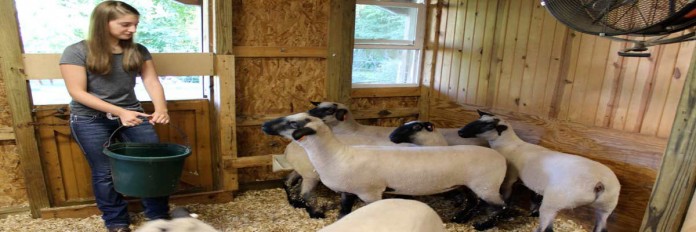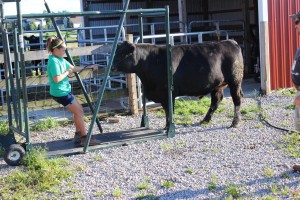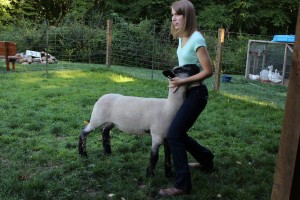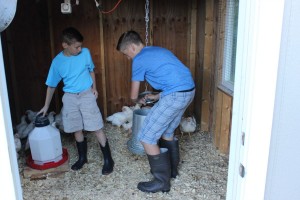
CHAGRIN FALLS, Ohio — The sun is just up, and Leah Fine is exhausted. She tries to sleep until the last possible minute, but she knows that Bella, Vinnie and Lugnut are surely up and waiting for her.
While it seems like she just left the barn, the 12-year-old pulls on her boots and heads across her family’s 20-acre farm outside Chagrin Falls.
Bella, a one-year-old heifer, is part of the family’s breeding program, but her 4-H project steers Vinnie and Lugnut will both be taken to market after the county fair.
Leah works inside the stall, tucked into a corner of the roughly 200-year-old barn on the former dairy farm, feeding the trio, giving them hay, then cleaning the stall.
“It’s gross if you don’t do it in the morning,” she says of the latter duty, pointing out that she will repeat the entire process before dinner.
As the remaining three head of cattle on her family’s small beef-hog-sheep and alpaca operation look on, Leah swings open the doors leading to a fenced area between the barn and a shed, and leads the massive Lugnut, the 2014 4-H project she will bring to the Great Geauga County Fair Aug. 28 through Sept. 1, out of the barn.
The 1,200-pound Angus cross hesitates a moment as the pair exit the dimly lit barn, planting his front hooves and pulling back in his halter when he notices a stranger in the yard.
“They can be antsy,” Leah says as she coaxes Lugnut through the barn door, repeating “walk, walk” in a gentle, yet firm, tone.
The steer is even less cooperative when Leah leads him into a wash stand, pushing and pulling him into position.
“He knows how to do this,” Leah grunts as the animal finally steps into the stand and Leah runs toward the shed for a hose.
Following his bath, Leah will walk Lugnut for the next two hours.

“They have to get to know you,” Leah said later of exercise routine. “You can tell the difference during competition.”
Lugnut has lived on the Fine farm since September, when Leah bought him from a 4-H member in Chardon. The name, according to Leah’s father, Dan, was given because of the steer’s propensity for acting like “a 600-pound rabbit” when he first arrived on the farm.
Unlike smaller 4-H projects, raising steers has left Leah with time for little else this summer. Still, the busy Kenston Middle School seventh-grader manages to work in soccer and, as soon as school begins again, homework.
Short break
Today, Leah will return to the barn around 5:30 p.m. to repeat the feeding-cleaning-walking rotation. Taking a break after her morning duties, she leans back on a rocking chair on the front porch and explains how it all pays off.
“I know how to buy, raise and sell a steer, but you have to put the work into it, and it can be tough,” she said. “Sometimes I’m so tired when I come home, but I have to go straight to the barn. It is a big responsibility, but it pays off. If your animal doesn’t trust you, they can be jumpy.”
Leah, who has had rabbit, poultry and hog 4-H projects, decided to raise steers after seeing her sister, Elise — now a sophomore at the University of Akron — raise them for years. Leah has already begun working with her 2015 project, a steer named Simba.
And the work doesn’t end in the barn.
“In the project books, you have to record things like what grain you used, adding up all your expenses,” she said. “And you have to attend a quality assurance (seminar) and keep up on shots and tagging in December. And I sent out 150 hand-written letters to potential buyers at the fair.”
Dan, a small business owner himself, said that while Leah does the work and pays back all of her project-related expenses, 4-H has become a family effort.
“The lessons it teaches are huge,” Dan said. “And I get to spend quality time with my daughter.”
Leah is using both the work experience and profit to augment her chosen career path, to become a second grade teacher.
“4-H teaches you a lot about completing a project, working on it every day, responsibility and time management,” she said. “But the best, I think, is the friendships I’ve made.”
Then she added with a giggle, “And I like being the person behind the gate at the fair, seeing all the fairgoers walking by and saying ‘yeah, that’s my animal.’”
Down the road in Auburn Township, some of Leah’s fellow Geauga County Junior Fair Livestock Sale Ambassadors group are hard at work on their 4-H projects as well.
Family affair
Members of the Montazzoli family describe themselves as suburban. But since moving to Ohio from Atlanta, 4-H has become all encompassing for Todd and Liz Montazzoli and their four children.

Todd, a marketing professional for Nestle in Solon, said when his oldest daughter, Jennifer, expressed an interest in a 4-H pygmy goat project seven years ago, his support was immediate.
“It was what they wanted to do, so I built them a barn,” he laughed.
Now, each of the Montazzoli children — Jennifer, 18; Anna, 15; Matthew, 12; and Phillip, 8 — spend up to six hours a day in the barn with their various projects.
Todd himself has become the adviser for the Junior Fair Livestock Sale Ambassadors group, which gives community presentations to encourage businesses and individuals to attend the junior fair livestock sale, as well as promote their businesses through the livestock sale.
Daily routine
While smaller animal projects don’t take up as much of the year as larger projects such as steer and hogs — lambs, for instance, are purchased in May, chickens in July, and ducks in June —the day-to-day care is equally time consuming and there is even less time to ready the animals for the fair.
Jennifer and Anna are up by 7:30 a.m. each day, feeding their four lambs — Emmit, Cody, Captain and Trooper — which share barn space with Phillip’s lamb Griffin, and Jennifer’s pygmy goats. Anna also shows ducks and both girls have shown rabbits in the past.
Following the morning feeding, the girls spend roughly an hour walking the lambs, both for exercise and practice for the fair’s showmanship competition.
Meanwhile, Matthew and Phillip are able to sleep in a bit longer than their sisters before tending to their coops of meat chickens and layers. But the boys have much do much more than simple twice-per-day feeding, watering and collecting eggs three times each day.

“You want to bring the ones that are most calm when you hold them and don’t flip out,” he said, holding Sadie, which took first in open class at last year’s fair. “You keep a record of each chicken to pick which four you bring to the fair. You’re looking for a list of defects (judges consider) like an uneven keel or missing a certain feather.”
Future plans
All four of the Montazzoli children return to the barn in the evening, when it is cooler for another round of feeding, watering and showmanship practice, sometimes well into the night, Jennifer said. In addition, detailed records must be kept in each project book.
Even friends must get in on the act.
“Oh yeah,” Jennifer laughed. “All our friends know that we’ll make them work.”
Like all 4-H clubs, the groups the children belong to — including Junior Fair Board, Junior Leadership, Feathers and Fleece, Pygmy Connection, and The Bunny Bunch — are completely member-driven, and community service projects range from yard work to visiting area nursing homes with smaller animals like rabbits.
The 32 Junior Fair Ambassadors members write, refine, and ultimately present a marketing plan encouraging businesses and civic groups to attend the fair and make a purchase at the market livestock sales.
“I don’t know if I’ll be a farmer, but there is so much 4-H has taught me about discipline,” Anna said. “Even when you don’t want to put in the work, they are animals, so you have to.”









